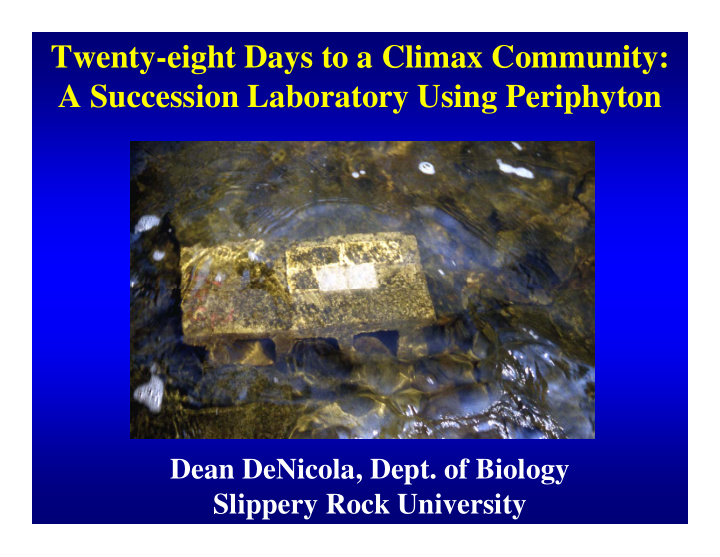



Twenty-eight Days to a Climax Community: A Succession Laboratory Using Periphyton Dean DeNicola, Dept. of Biology Slippery Rock University
Why Use Freshwater Periphyton? • Rapid reproduction rates means succession occurs in a matter of weeks not decades • Repeated Measures method is more intuitive for understanding succession than chronosequence • Involves the concept of species guilds (growth forms) and conceptual models in community ecology
Lab Outcomes: • To contrast periphyton succession in a lake and stream based on changes in taxonomic composition • To compare successional changes in algal growth forms to published models • To understand mechanisms of succession proposed by Connel & Slatyer and explain how they might apply to this study • To increase awareness and become familiar with different types of algae
Unglazed clay tiles attached with silicone adhesive to cement blocks
Students (or you) place blocks in high irradiance areas in a stream and in a pond or lake about 0.25 m deep Remove tiles and scrape with brush ca. Days, 4, 8, 16, and 28
Day 8
Day 16
Day 28
Students count and ID about 200 taxa (genus and growth form) from wet mounts at 400X
Useful Taxonomic References To Make Up Your Own Picture Key • 1971. C.I. Weber. A guide to the common diatoms at water pollution surveillance system stations . EPA. • 1988. J. Needham. A guide to the study of freshwater biology . McGraw Hill. • 1996. E. Cox. Identification of freshwater diatoms from live material . Chapman & Hall. • 1997. T.J. Entwisle et. al. Freshwater Algae in Australia . Sainty and Assoc. • 2000. M. Kelly. Identification of common benthic diatoms in rivers . Field Studies Council.
Other ID Aids: Photos of common taxa Power Point presentation with images from the web
Lake growth form model Growth Forms: (Hoagland et al. 1982) *Prostrate *Erect immobile *Stalked *Motile *Chain *Colonial prostate greens and BG’s *Filamentous greens *BG filaments
Stream growth form model based on (Hudon and Bourget 1983)
Students enter their counts into a Excel file and the data is pooled for the class
Diatoma Synedra Navicula Gomphonema Day 4 Melosira Oscillatoria Stigeoclonium Other Day 8 Stream Taxa Day 16 Day 28
Erect immobile Prostrate Stream Motile diatoms Day 4 Growth Forms Stalked diatom Diatom chain Filamentous greens Filamentous cyanobacteria Other Day 8 Stream Growth Forms Day 16 Day 28
Scenedesmus/Ankistro. Oedogonium Unicellular greens Day 4 Melosira Navicula Cymbella Synedra Other Day 8 Pond Taxa Day 16 Day 28
Unicellular/col. greens Erect immobile Prostrate Pond Motile diatoms Day 4 Stalked diatom Growth Forms Diatom chain Filamentous greens Other Day 8 Pond Growth Forms Day 16 Day 28
Lab Report • Presentation of changes in taxonomic structure and growth forms in properly constructed figures • Discussion of successional sequence, contrasting differences in the lake and stream • Do the changes in growth form fit the generalized models for lakes and streams? • Discuss how Connel and Slatyer models may apply, and how you would test the models
Possible Modifications • Compare succession in areas of different light or current speed • Compare succession with and without grazers using an exclosure • Determine relative changes in cell density during succession by scraping the same area & bringing samples up to the same volume. Students pipette a known volume onto their slide and count a given number of transects on the slide
Diatoms = Good student evaluations
Recommend
More recommend